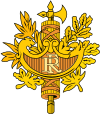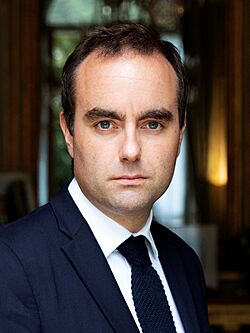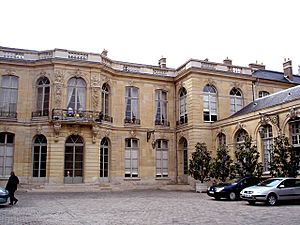Prime Minister of France facts for kids
Quick facts for kids Prime Minister of theFrench Republic |
|
|---|---|

|
|

|
|
| Style |
|
| Member of |
|
| Reports to | |
| Residence | Hôtel Matignon |
| Seat | Paris, France |
| Appointer | President |
| Term length | At the president's pleasure, contingent on the officeholder ability to command parliamentary confidence |
| Constituting instrument | Constitution of France |
| Precursor | Several titles were used since the Ancien Régime |
| Inaugural holder | Charles Maurice de Talleyrand-Périgord |
| Formation | 9 July 1815 |
| Salary | €178,920 annually |
The Prime Minister of France (in French, Premier ministre français) is a very important leader in the French Republic. They are the head of government, which means they lead the country's daily operations. The Prime Minister is in charge of the Council of Ministers, a team of people who manage different parts of the country.
The Prime Minister holds the second-highest position in France, right after the President. The President chooses the Prime Minister. However, the President cannot simply ask the Prime Minister to leave office. The National Assembly, which is like France's parliament, can remove the entire government, including the Prime Minister. Once appointed, the Prime Minister suggests a list of other ministers to the President.
The current Prime Minister of France is Sébastien Lecornu. He was appointed on 10 October 2025.
Contents
Choosing the Prime Minister
The President appoints the Prime Minister. In theory, the President can pick anyone. But in reality, the choice depends on who has the most support in the National Assembly. This is because the National Assembly can force the government to resign if they don't agree with its actions. They do this by passing a special vote called a motion of no confidence.
Sometimes, the President and the majority in the National Assembly belong to different political parties. This situation is called cohabitation. During cohabitation, the Prime Minister is mainly responsible to the parliament, not just the President.
For example, in 1986, President François Mitterrand (from the Socialist Party) had to appoint Jacques Chirac as Prime Minister. Chirac's party, along with its allies, had won the majority in the legislative election. This meant Mitterrand and Chirac, from different parties, had to work together.
Most Prime Ministers are chosen from the members of the National Assembly. But sometimes, the President picks someone who hasn't been elected to parliament. This might be because they have a lot of experience in government work or business. For instance, Dominique de Villepin served as Prime Minister from 2005 to 2007 without holding an elected office before.
After being chosen, a Prime Minister doesn't have to ask for a special vote of confidence from the National Assembly. Their appointment by the President and the approval of the government is usually enough.
What the Prime Minister Does
The Prime Minister is responsible for leading the government's actions. The government's job is to decide and carry out the country's policies, especially for things happening inside France. The President usually focuses more on national defense and foreign policy. The President also makes sure all parts of the government work well together.
Other ministers in the government are chosen by the President, but only after the Prime Minister suggests them. Usually, the Prime Minister and the President work very closely. However, during a period of cohabitation, the Prime Minister often takes the lead on domestic issues. The President then focuses more on defense and foreign affairs.
The Prime Minister can also "engage the responsibility" of the government before the National Assembly. This is a special way to pass a bill. If the National Assembly doesn't agree with the bill and votes against the government, the government might have to resign. But if they don't vote against it, the bill passes automatically. This method is sometimes used for important bills that might be difficult to pass through normal voting rules.
The Prime Minister is the only member of the government who can introduce new laws in Parliament. Before the President can dissolve the National Assembly (which means calling for new elections), they must talk to the Prime Minister and the leaders of both houses of Parliament.
A Look at History: How the Role Changed
In the past, during the Third Republic, the head of government was called the "President of the Council of Ministers." Outside of France, people often called them "prime minister" or "premier."
This leader had powers similar to the prime minister of the United Kingdom. However, France's parliament had many political parties, and governments often struggled to keep enough support. The parliament could force the entire government out of office with a "vote of censure." Because of this, governments often changed very frequently, sometimes twice a year! This made the "President of the Council" a less powerful figure. They were often just the chairman of the cabinet, not a strong leader.
After several attempts to make the role stronger, France adopted a new system in 1958, called the Fifth Republic. This is when the position was officially named "Prime Minister" and took its current form. The 1958 Constitution made the Prime Minister's position much stronger. For example, it made it harder for the parliament to remove the government.
Since 1958, a government has only been removed by a motion of no confidence twice. The first time was in 1962. The second time was in 2024, when Michel Barnier's government was removed. This happened after his government used a special rule to pass a budget without a full parliamentary vote.
Former Prime Ministers Still With Us
There are eighteen former Prime Ministers of France who are still alive. The most recent former Prime Minister to pass away was Jacques Chirac (who served from 1974–76 and 1986–88) on 26 September 2019.
- Living former Prime Ministers of France
-
Laurent Fabius
1984–1986
20 August 1946 -
Édith Cresson
1991–1992
27 January 1934 -
Édouard Balladur
1993–1995
2 May 1929 -
Alain Juppé
1995–1997
12 August 1945 -
Lionel Jospin
1997–2002
12 July 1937 -
Jean-Pierre Raffarin
2002–2005
3 August 1948 -
Dominique de Villepin
2005–2007
14 November 1953 -
François Fillon
2007–2012
4 March 1954 -
Jean-Marc Ayrault
2012–2014
25 January 1950 -
Manuel Valls
2014–2016
13 August 1962 -
Bernard Cazeneuve
2016–2017
2 June 1963 -
Édouard Philippe
2017–2020
28 November 1970 -
Jean Castex
2020–2022
25 June 1965 -
Élisabeth Borne
2022–2024
18 April 1961 -
Gabriel Attal
2024
16 March 1989 -
Michel Barnier
2024
9 January 1951 -
François Bayrou
2024–2025
25 May 1951
See also
 In Spanish: Primer ministro de Francia para niños
In Spanish: Primer ministro de Francia para niños




















